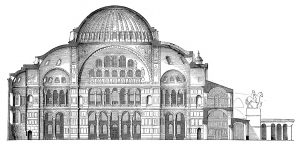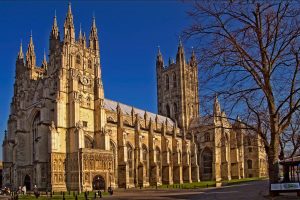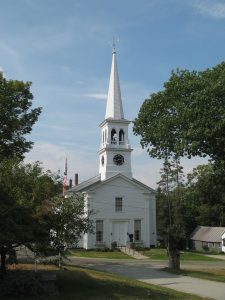
If you’re a regular here on my blog you’ve seen me writing on a variety of topics relating to Orthodox Christianity.
I don’t mean “little ‘o’ orthodox” — like any Christianity with good theology.
We’re talking “big ‘O’ Orthodox” — Eastern Christianity, the part that was divided from the West back in 1054 and is still the second largest body in global Christianity.
It all ties into personal experience. Participating in the Vespers services of Orthodox churches in Dubuque and Pittsburgh has kept me grounded and growing in tumultuous times. So I’ve written about the theological richness of their hymns, the particular gifts of their special Lenten services, and about many of their saints.
So I thought to myself: What if one of my readers got intrigued about Orthodoxy and wanted to see it firsthand? You might look up your local Orthodox Church and stop by some Sunday morning.
It might happen.
And you might find yourself very confused by what you experience.
Making Sense of Your First Visit to an Orthodox Church
Here’s what often happens: A Protestant in an Orthodox church immediately says “It’s too Catholic!” — even though what is happening would actually be quite foreign to a Catholic as well.
I’d love instead for you to have a really positive encounter with Orthodox worship. I think if you know a few of the differences in advance, maybe just half a dozen, and know what they actually mean, then you are more likely to find the experience of Orthodoxy meaningful, inviting, and a catalyst to growth.
Common Ground
Rest assured that there is a vast amount of common ground between the Orthodox and Western branches of the faith.
- They worship the same one God who is eternally the Trinity: three Persons, Father, Son, and Holy Spirit.
- They worship, love, and follow the same Jesus Christ who is truly human and truly divine.
- They take baptism and the Eucharist very seriously.
Those are just obvious starters.
Domes vs. Steeples
Assuming the church you visit was originally built as an Orthodox church, you can make your first important observation before you even get out of your car.
Look up.
See the shape of the roof line. Now compare in your mind with the Protestant or Catholic church down the street, or one you usually attend.

Most Protestant and Catholic churches are built with spires on top. The spire might be central. There might be more than one, at the corners. Whether it is a stone cathedral from the middle ages, or an early American clapboard meeting house, long and thin or short and squatty, our churches often have points.

Orthodox churches on the other hand, tend to be round on top. They have domes instead of spires.

Now sure, sometimes you see what are called “onion domes”: bulbous and round, with a small point in the middle. But you also see great rounded domes, modeled on the ancient Church of Holy Wisdom, Hagia Sophia in Istanbul (formerly Constantinople).
Witness vs. Presence
What’s the big deal?
Well, whether today’s worshippers think about it or not, the planners and architects embodied statements about their faith in the buildings they constructed.
Spires are on our churches to point our attention upward, toward heaven.
The building bears witness to a separate reality. “Come inside,” the building says, “and we’ll help you redirect your attention to God!” The building, and the faith we learn of, calls us to be witnesses.
We leave as representatives of the Body of Christ, called to bear that same witness, helping people turn toward Christ, to live in light of heaven.
That’s all good.
The church as dome sends a different message about the same faith: The dome is heaven, and we are invited in.
It is more about presence than about witness.
Think back to the first chapter of Genesis. God put a dome, a “firmament” over the earth. We look up at the sky and it looks as if we lived under a huge blue bowl — a dome.
An Orthodox church is a microcosm of heaven. The building calls out “Come in and enter God’s throne room.” When you get inside the worship space, you will probably find the ceiling painted sky blue — with Jesus at the very center, at the top of the dome, looking down as our ruler.
- Entering an Orthodox church is not primarily about being pointed toward heaven.
- You are understood to be entering into heaven itself.
I’ll say more, later in this series, about what you will see and experience there. But for now imagine the biblical underpinnings of Orthodox worship as the passages portraying God’s throne room.
- Isaiah chapter 6 gives the prophet’s vision of God enthroned in the earthly temple, surrounded by angels that perpetually sing “Holy, Holy, Holy is the Lord Almighty! Heaven and earth are full of his glory!”
- Revelation four and five look into heaven and find people and creatures surrounding God’s throne, eternally singing out in worship, “Holy, Holy, Holy is the Lord God almighty, who was, and is, and is to come!”
That’s what a dome is trying to tell you — and to invite you into.
Instruction vs. Experience
Even before you go in, the dome hints to you of a great continuum. All Christian worship finds its place on it. Instruction is on one end; experience is on the other.
I’m a Presbyterian. We are all about instruction. My tradition burst on the scene in 16th century Europe with a deep concern that the nominally Christian populace knew almost nothing about their faith.
Worship is about the Word of God, which we read, and preach, and respond to.
But we didn’t stop there with our explanation. Oh my no. Today in a Presbyterian service almost nothing comes without explanation.
- We don’t just stand and sing a hymn. Someone explains which book it is in, what page it is on, what it is about, and why we are singing it just at this point of the service.
- It can be hard to tell when the announcements break off and worship begins.
When you step inside an Orthodox church it is all about experience. You are at the absolute opposite end of the spectrum.
- You will experience all kinds of things.
- No one will explain anything. (Hey, that’s why I’m writing these blog posts.)
But that is exactly true to the concept. Going into this building is not an intellectual reminder of where you should aspire in your life. You are, for a brief while, stepping into the activity that is going on eternally in God’s throne room in heaven.
The church is your meeting point between heaven and earth. It is, as the Celtic Christians might say, a “thin place.”
It is almost all about experience. The activity of God’s throne room will unfold around you, and you will be there in the midst of it.
So before you go in, look up. Know that you are about to experience what the Orthodox think of as “the awe-inspiring mysteries of God.”
- You should not expect to be guided and directed step-by-step.
- You should not think anything will be explained to you.
- You will, on the other hand, be warmly welcome (whether anyone says so or not) to experience a foretaste, a real taste, of the life of heaven.
The first time you’ll probably do best to let the experience just roll over you. If you come back, more will grow familiar, taking on deeper and richer meaning.
If you strike up a friendship with a member or a priest they will surely explain what is going on, or guide you to helpful books. If you ask.
But the point is to be there.
++++++++++++
This post is the first of a series. To read the next installment, click here.
I’d love to send all these posts, as well as my other articles and announcements, directly to your inbox. Sign up for my weekly(ish) newsletter down there in the black box with the orange button, and they will wing their way to you across the interwebs…

Thank you for this insight into domes vs steeples. I was on a train from Krakow in Poland to Prague and then onto Budapest. I noticed the shape of the roofs of churches changing in their architecture. I was fascinated! Your blog explains this fully. thank you.
Thanks Erin!
I’m jealous— glad for you that you get to see such sights. That post is part of a series on first experience of Orthodox worship. If you follow the links to the others I’d love to hear your thoughts.
Blessings,
Gary